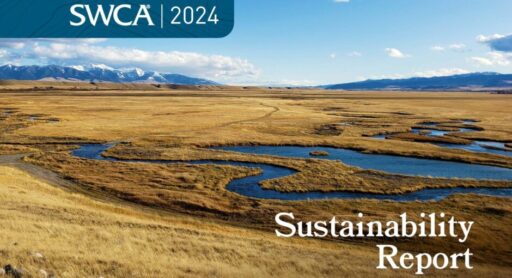2025
Comparably’s Best Company Outlook
* Providing engineering services in these locations through SWCA Environmental Consulting & Engineering, Inc., an affiliate of SWCA.

From the experts we hire, to the clients we partner with, our greatest opportunity for success lies in our ability to bring the best team together for every project.
That’s why:

At SWCA, sustainability means balancing humanity’s social, economic, and environmental needs to provide a healthy planet for future generations.
SWCA employs smart, talented, problem-solvers dedicated to our purpose of preserving natural and cultural resources for tomorrow while enabling projects that benefit people today.

At SWCA, you’re not just an employee. You’re an owner. Everyone you work with has a stake in your success, so your hard work pays off – for the clients, for the company, and for your retirement goals.
An Ounce of Prevention: SWPPP and SPCC Plans Explained
Stormwater Pollution Prevention Plans (SWPPPs) and Spill Prevention Control and Countermeasure (SPCC) plans are both authorized under the Clean Water Act to prevent water quality impacts.
Stormwater Pollution Prevention Plans (SWPPPs) and Spill Prevention Control and Countermeasure (SPCC) plans are both authorized under the Clean Water Act to prevent water quality impacts. We asked SWCA’s senior environmental specialists and project managers to explain when SWPPPs and SPCCs are required and how to implement them.
SWPPPs are meant to prevent the contamination of surface waters as a result of stormwater runoff from construction or industrial sites that may contain polluting materials. Under the Energy Policy Act of 2005, oil, gas, and transmission facilities are exempt from SWPPP requirements in the case of “clean” stormwater runoff. However, even if oil or gas facility owner/operators choose the exemption they must show how they will protect wetlands using best management practices. And regardless of facility type, a discharge of pollutants of a recordable quantity — such as sediment — or a discharge that contravenes a water quality standard does require an owner/operator to obtain a stormwater permit and prepare a SWPPP.
In fact, we recommend that clients obtain a stormwater permit and develop a SWPPP even if it is not strictly required under the regulations because when there is a discharge, regulators look more favorably upon an owner/operator with a SWPPP than one without a plan.
Stormwater permitting is done at the state level, and therefore requirements vary from state to state. For example, North Dakota requires a SWPPP and stormwater permit application (also called a Notice of Intent) to be filed seven days before construction starts. In contrast, Kansas requires a permit application to be filed 60 days before construction starts, and a Professional Engineer, Professional Geologist, or Certified Professional in Erosion and Sediment Control must review and stamp the plan. In certain situations, such as when a project would require design and construction of a stormwater retention basin, the design would require a Professional Engineer’s stamp. Waste disposal facilities and saltwater disposal wells also require an industrial permit and SWPPP.
SPCC plans are meant to prevent oil from leaving a site and traveling to surface waters of the United States or adjoining shorelines. SPCC plans help a client answer these questions:
If a problem arises at a facility the SPCC plan serves as a guide for first responders to know what to do, where, and when. For example, a responder should be able to tell from the plan that product flows from point A to point B, with a valve at a certain location in between that can be closed to stop the flow of the product. Wherever a spill occurs, the responder will know where inside or outside the facility to begin containment efforts.
SPCC plans have three major components:
SPCC plans are a federal requirement administered by the EPA; they cannot be delegated to the states. Except for a few exemptions, the SPCC rule applies to any facility with an aggregate total of 1,320 gallons of oil or more in containers of 55 gallons or greater. So whether a facility has one tank with a 1,500-gallon capacity or 24 separate 55-gallon drums, the rule would apply. Even though this is a federal requirement, an SPCC plan must be reviewed, certified, and stamped by a Professional Engineer licensed in the state in which the facility exists.
Part of the SPCC rule is a substantial harm determination, which is tied to the total volume of oil stored on-site and its location relative to sensitive environmental areas or public water supplies. Sites within a certain distance of sensitive resources require a Facility Response Plan, which details how to respond in a worst-case spill situation (see the EPA’s web page bit.ly/EPA-FRP for more details).
We have prepared SPCC plans for several Abraxas Petroleum facilities in Montana, North Dakota, and Wyoming, as well as an SPCC plan and Facility Response Plan for Plains Terminals of North Dakota’s terminal facility at Johnsons Corner. We also have prepared SPCC plans for natural gas compressor stations and gas fractionation plants in North Dakota and Texas for ONEOK. And we have conducted SPCC inspections and updated SPCC plans for oil and gas production facilities in New Mexico for Encana Oil & Gas, among others.
A typical SPCC plan may take a week or two to complete, depending on the complexity of the facility and what fits within the SPCC rule and what doesn’t. For simpler facilities with good site drawings and engineering plans, we have produced plans more quickly. One time we got a call at 6 p.m. on a Wednesday with a request to complete an SPCC plan for a railway facility in North Dakota by the following Monday when operations were due to start. We did the site inspection on Thursday, wrote the plan on Friday, sent it to a staff geologist and a staff engineer for review over the weekend, and were able to get it to the client by Sunday night. That was an unbelievably fast turn, but the nature of that facility’s design and the solid information available made our job much easier than normal.
SPCC plans must be reviewed and recertified every five years and/or within six months of substantial technical changes to a facility that would impact its oil spill potential. Such changes include the manufacture of new products; revised processes at the site; or the addition of tanks, containers, or equipment that would have a material effect.
Essentially what we do is cost avoidance. The fine can be $10,000 per day for stormwater infractions, and the penalty can be much higher in the case of SPCC rule infractions if a client undergoes an EPA audit or inspection and is found to be out of compliance. We write our SPCC plans to pass EPA audits by addressing both the letter and the intent of the regulations. We look at a client’s circumstances, location, and other factors to determine what measures are required. We also understand the intricacies of the SPCC rule and the complexities of different facilities to create solid plans that will pass EPA muster.
Before having an SPCC plan prepared, provide as much information as possible about your facility. A good description of how the facility functions is important to understand the full processes at work and write an adequate plan. A detailed site layout, thorough process descriptions, and a listing of all the byproducts that may meet the definition of oil (which is a very broad definition, by the way) help with the development of a comprehensive plan that will cover all the bases.
It’s equally important at the end of the planning process not to simply put these plans on a shelf and forget about what is in them. Follow through on recommended procedures in the plan, such as conducting regular inspections and keeping adequate records.
In terms of stormwater planning and permits, we advise clients to take their responsibilities under the permit seriously, for example, in regards to inspections, corrective actions, and revegetation efforts. The old adage is true. An ounce of prevention and having a good plan in place can make a big difference in saving costs and regulatory headaches down the road.